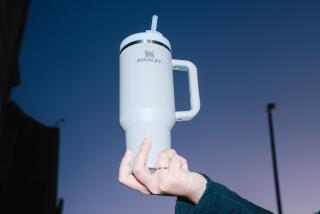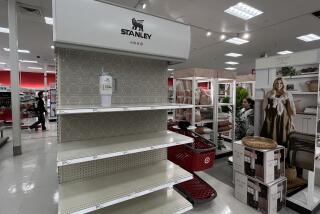In Their Cups and Proud of It
- Share via
Kristin Letua, 9, stands like an Old West gunfighter at high noon, fingering a dozen plastic cups.
“C’mon, somebody race me,” she says, hurling a challenge into the milling after-school crowd at the Boys and Girls Club of Oceanside.
A boy materializes. He sets up his own cups across from Kristin’s on a carpeted, waist-high table. An onlooker says, “Go!”
There is a blur of hands moving at speeds the eye can’t register, and the cups rise in pyramids on either side of the table. Then, in another flurry, they dissolve back into their original piles. It’s over in less than six seconds. Kristin slams her final cup into place with authority.
“And still champion!” she mugs. Her opponent gives her a good-natured little shrug.
Cupstack magic has struck again. It’s been nearly a decade since Wayne Godinet invented cupstacking as a way to jolly up some bored kids, but it still makes him feel good.
“It doesn’t get old, not when you can see how much it means to these kids, how much it’s teaching them,” said Godinet, a unit director at the Oceanside club where he has worked for 16 years.
He sits in his office, where the door is always open to the children, and talks about a brainstorm that blew in on a restless afternoon in 1981, when the kids seemed tired of the traditional basketball, Ping-Pong and Foosball. It hit Godinet as he aimlessly pushed around some empty paper cups from the snack bar.
“We said, OK, stack these cups as fast as you can, then run and touch the wall, like a relay,” he recounts. “All of a sudden, the kids were having a great time.”
Nearly 10 years, a few refinements and a six-page rule book later, the game is gaining participants everywhere, with cupstack programs in place in youth clubs, schools, church groups and special education classes in 37 states. Godinet thinks the boom is related to the game’s simplicity.
Played one-on-one or with relay teams, the basic object of the game is to “upstack” the cups into pyramids and “downstack” them to their original positions as quickly as possible without fumbling them. According to Godinet, cupstacking improves hand-eye coordination and concentration, but, more importantly, it offers lessons in self-worth, concentration and the rewards of hard work and practice.
“It doesn’t matter how tall or how small you are, or how athletic you are, or whether you’re a boy or a girl,” he says. “There are no shortcuts. It’s just practice. This is one sporting event where kids corner the market. They own it.”
Some of the fastest cupstackers in the country hail from Oceanside, the game’s birthplace and the site of the National Cupstacking Championship.
Now perched at the top of the heap is club member Matt Adame. The 9-year-old is the current individual national champion and is a member of the club’s relay team, which will compete with cupstackers from around the nation in May.
“I started when I was about 4,” Matt explains. “My older brother learned at the club, and he taught me. Then I just practiced, like 30 minutes a day, every day. It’s fun to do when there’s nothin’ else to do. It keeps you off the streets.”
Matt’s affiliation with the club’s self-titled “Professional Cupstack Drill Team” has taken him to places he never thought he would go--youth conferences in Houston and Minnesota, and, most recently, the stage of “The Tonight Show.”
On a tip from a Johnny Carson staff member who’d seen Matt in action, the show arranged for a caravan of limos to shuttle the 10-member team to Burbank. On Nov. 2, the boys and girls wowed the cast and audience alike with a flashy demonstration that followed Carson’s monologue.
“He was funny, but he couldn’t really cupstack,” says Matt, who briefly took the hot seat for some banter with Carson.
The exposure brings both opportunity and challenge to Godinet, who for several years has sold cupstacking kits of his own design and manufacture through a quiet network of educational and institutional channels. To date, he estimates there are about 25,000 kits in circulation.
“I didn’t want this to be perceived as a toy,” he says of his low-key marketing strategy. “We’re very serious about using cupstacking as an educational tool.”
The $6 kit consists of a dozen cups of heavy plastic (which have a small hole punched in the bottom to reduce air resistance during stacking) and a stem-and-hook arrangement that lets avid stackers latch their cups to a belt loop or purse string, always at the ready.
“It’s funny, they get so they use it like a security blanket,” Godinet says. “They don’t like leaving home without it. I think in a way it becomes a symbol of their ability to do something well.”
Since the Carson show, a more general demand for the kits has been rising. His company, Karango Enterprises, is responding by gearing up for the mass production and distribution of cups, videos, T-shirts and cupstacking tables.
“But first, it’s about kids, and we wanted to solidify that,” says Godinet. “I’ve seen this thing work at the program level. Black children, white children, red children, tall, short, large, small--all participating, getting along with each other and having fun. And smiling. That’s what means more to me than anything else.”
Additional information on cupstacking is available from the Karango Cupstack Co., P.O. Box 1657, Oceanside, CA. 92054. (619) 967-0073.


